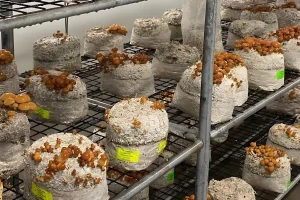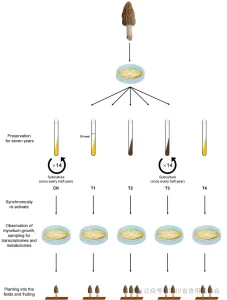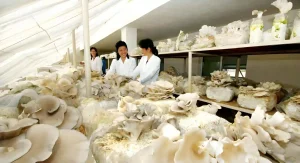1. Cultivated Varieties

Yunnan Province boasts a rich diversity of wild morel mushroom varieties. However, currently, the number of varieties that have been identified at the provincial level or above for cultivation and are recognized by growers remains limited. The main cultivated varieties are Morchella sextelata, Morchella septimelata, and Morchella importuna. Among them, Morchella sextelata has the largest cultivation area.
2. Cultivation Area
The cultivation area of morel mushrooms in Yunnan Province has been steadily increasing. Except for Xishuangbanna Dai Autonomous Prefecture, morel mushrooms are cultivated in the remaining 15 cities and prefectures of the province. From 2022 to 2023, the total cultivation area in the province was approximately over 20,000 mu.
3. Cultivation Methods
Currently, the main cultivation methods of morel mushrooms in Yunnan are as follows:
| Cultivation Method | Description |
| Field Cultivation | Utilizes greenhouses, small arched sheds, and simple shade nets |
| Under – forest Cultivation | Covers cultivation under economic forests, well – planned artificial forests, and Yunnan pine forests |
4. Cultivation Costs
Currently, the price of morel mushroom strains in Yunnan ranges from about 7,000 yuan to 9,000 yuan. For each mu of land, 200 – 250 kg of morel mushroom strains are required, along with 700 – 1,000 kg of nutrient bags (about 1,800 – 2,200 pieces). Based on the exchange rate on February 21, 2025, 7,000 yuan is approximately equivalent to $965.34, and 9,000 yuan is approximately equivalent to $1,230.87.
5. Economic Benefits
The high market price of morel mushrooms has brought significant economic benefits to both farmers and enterprises. In Yunnan, the market price of morel mushrooms fluctuates greatly due to market supply – and – demand relationships. In recent years, before the Spring Festival, the price per kilogram ranged from 200 – 300 yuan, and after the Spring Festival, it dropped to about 200 yuan. The lowest price was 120 – 140 yuan. The yield per mu can reach 150 – 300 kg. Calculated at a market price of 100 yuan per kilogram, the output value per mu can reach 30,000 – 60,000 yuan. After deducting costs, the net profit per mu can reach 10,000 – 20,000 yuan, becoming a key way for farmers to increase their income. Based on the exchange rate on February 21, 2025, 30,000 yuan is approximately equivalent to $4,171.5, 60,000 yuan is approximately equivalent to $8,343, 10,000 yuan is approximately equivalent to $1,390.5, and 20,000 yuan is approximately equivalent to $2,781.
6. Social Benefits
The morel mushroom cultivation industry has significantly promoted local employment. From strain production, cultivation management to product processing and sales, a large number of job opportunities have been created. In addition, the development of the industry has also promoted the adjustment of the rural industrial structure and accelerated the process of agricultural modernization.
7. Development Prospects
With the continuous growth of the global demand for healthy food, the market for morel mushrooms has broad prospects. Yunnan has unique natural conditions and a solid technical foundation in morel mushroom cultivation. In the future, there is hope to further expand the cultivation scale, improve product quality, strengthen brand building, and expand domestic and foreign markets, building the morel mushroom industry into an important pillar of Yunnan’s characteristic agriculture. At the same time, there is huge potential for development in areas such as strain research and development, innovation in cultivation techniques, and deep – processing of products, which will push the industry to a higher level.
More:
- 2025: The Year Agriculture Enters the AI Era – A New Wave of Transformation on the Horizon IAgricultural AI Revolution
- Algarikon Zero Project: How a Spanish Firm Transforms Invasive Algae for Edible Mushroom Cultivation
- 🔍 Research Uncovers Key Mechanisms of Morel Strain Degradation
- Spain: Edible Mushrooms Found to Alleviate the “Salty” Dilemma of the Meat Industry
- Yunnan’s Morel Mushroom Industry: Current Status and Prospects


